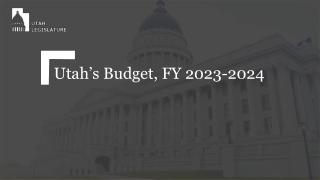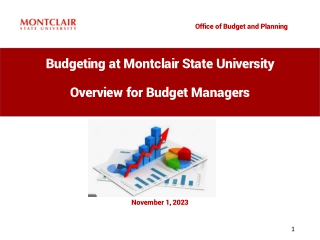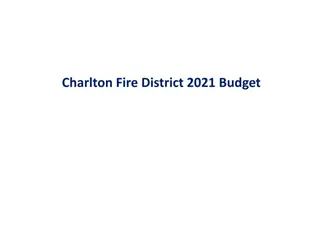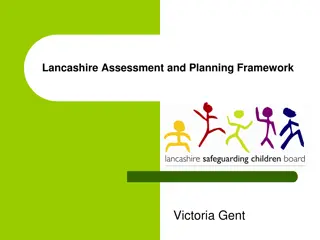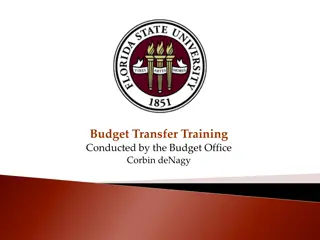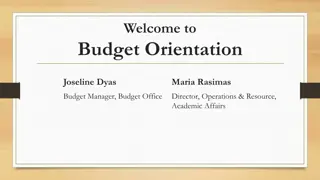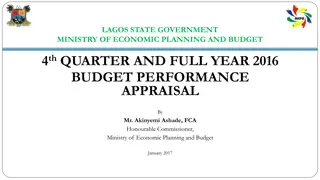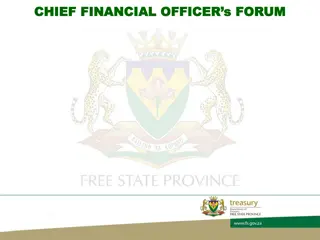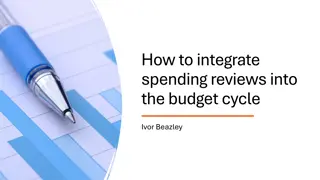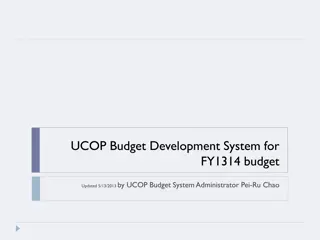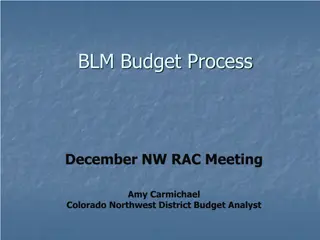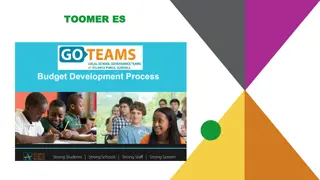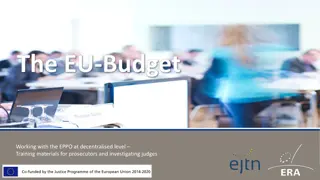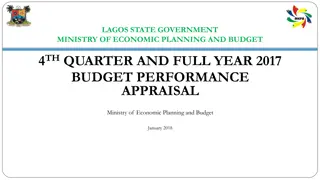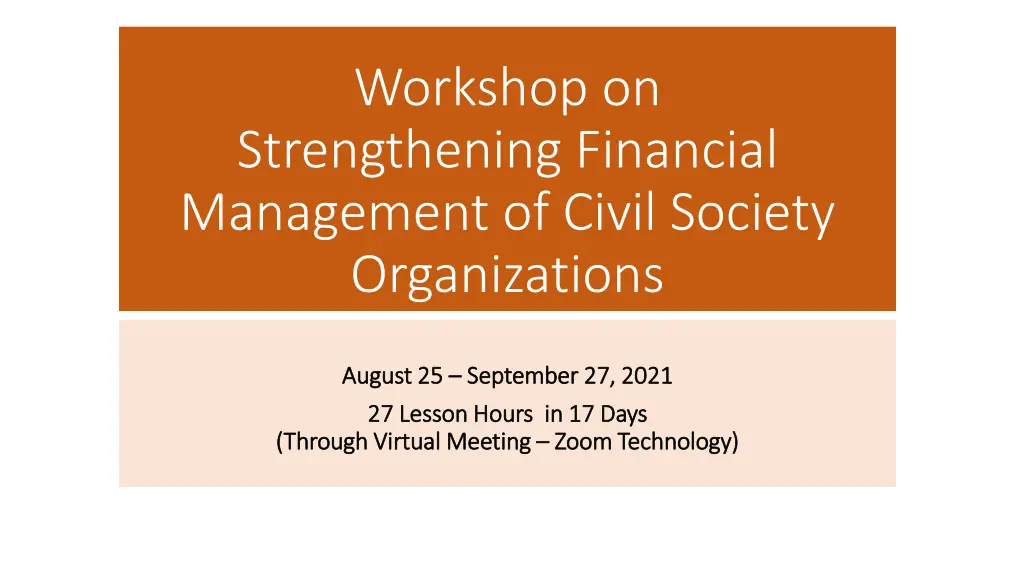
Strengthening Financial Management of Civil Society Organizations Workshop
Join the virtual workshop from August 25 to September 27, 2021, to learn about financial planning, budgeting, and monitoring in civil society organizations. Enhance your skills in strategic budget processes, performance evaluation, and budget implementation for sustainable and accountable financial management.
Download Presentation

Please find below an Image/Link to download the presentation.
The content on the website is provided AS IS for your information and personal use only. It may not be sold, licensed, or shared on other websites without obtaining consent from the author. If you encounter any issues during the download, it is possible that the publisher has removed the file from their server.
You are allowed to download the files provided on this website for personal or commercial use, subject to the condition that they are used lawfully. All files are the property of their respective owners.
The content on the website is provided AS IS for your information and personal use only. It may not be sold, licensed, or shared on other websites without obtaining consent from the author.
E N D
Presentation Transcript
Workshop on Strengthening Financial Management of Civil Society Organizations August 25 August 25 September 27, 2021 September 27, 2021 27 Lesson Hours in 17 Days 27 Lesson Hours in 17 Days (Through Virtual Meeting (Through Virtual Meeting Zoom Technology) Zoom Technology)
Financial Management Module 2: Financial Planning and Budgeting About This Module About This Module The financial planning and budgeting module of this workshop is designed, you to learn about strategic and collaborative budget process or bottom up and integrated budget preparation process to ensure that resources are being used most effectively to meet your mission or goals and that your organization remains sustainable and accountable to its stakeholders.
Financial Management Module 2: Financial Planning and Budgeting About This Module About This Module This module will provide a framework for evaluating the performance of managers in meeting individual and sub-project level targets. Management can measure progress against the original plan, making adjustments where necessary. It controls income and expenditure and informs remedial action when there is deviation from the plan. The tools and guidance introduced through this module can help you to set up, revise or realign existing finance planning and budgeting system, process or practice.
Lesson Plans 2: Finance Planning and Budgeting Process Introduction: Introduction: overview, policy framework and the planning process Budgeting Framework: Budgeting Framework: excel spreadsheet workbook designed to allow users to clearly identify the linkages between all elements of a plan is to provide a structure for developing an integrated plan and budget Budget Planning and Preparation Process: Budget Planning and Preparation Process: preparation of planning directions; preparation of budgets; and approval of budget
Lesson Plans 3: Budget Implementation, Monitoring and Review Implementation and Monitoring: Implementation and Monitoring: periodic reporting and reviews for compliance with approved budget including reporting requirements as per the Donor Agreement - Variance Report; Progress Report etc. Budget Revisions: Budget Revisions: changes in approved budget for successful delivery of work program through reallocation, realignment and rescheduling Supplementary Budget Supplementary Budget
Budgeting Framework Planning directions to be established by Sampled CSO s management in relation to each Budget period. The planning directions will provide guidance for the preparation of the Work Program and Budget (WPB) for each biennium budget. Personnel should adhere to the principles and approaches of the planning directions in undertaking the preparation of the WPB of Sampled CSO
Budgeting Framework Budgeting activities should aim to produce a coherent results-based Work Program and Budget (WPB) that incorporates programmatic and operational priorities of sampled CSO over the Budget period that are in line with the framework and guidance set out in the planning directions through: a) Activities that support decision making for achieving better accountability through integration between strategic planning and budgeting throughout the organization b) Facilitation of flexibility in the adjustment of budget-related activities to match changes in strategic and operational priorities direction.
Budgeting Framework This includes the budget planning process, periodic reviews, reallocation of resources and the application of systems and processes. Budgeting activities should be carried out in accordance with the Article 3 of Financial Regulations of Sampled CSO, and should reflect congruence with the existing organizational structures so as to enhance accountability. Article 3 Financial Regulations of Sampled CSO Financial Regulations of Sampled CSO
Budgeting Framework Planning and Preparation Implementation and Monitoring Revisions Changes in approved Budget for successful delivery of Work Program through: Reallocation Realignment Rescheduling Preparation of planning directions Preparation of budgets Approval of Budget Periodic reporting and reviews for compliance with approved Budget
Budget Planning and Preparation Process The planning directions should indicate I. the programmatic and operational priority areas that will either build on achievements of prior period or reflect new directions in context of mid-term strategic plan, and II. the timelines for the milestones. This will provide the basis of top-down organization-wide planning.
Budget Planning and Preparation Process Budgeting guidelines and related templates shall provide instruction on how to arrive at best possible budget estimates for priorities identified in the planning directions. The planning directions and budgeting guidelines will be used by the respective organizational units in preparation and submission of their budgets following a bottom up and integrated budget preparation process within a given budgetary ceiling.
Budget Planning and Preparation Process The Work Program and Budget (WPB) shall be prepared for the biennium, and each year of the Budget shall follow the Sampled CSO s financial year in accordance to the Financial Regulations. Budgeting for earmarked projects should also follow the Sampled CSO s financial year, notwithstanding whether the beneficiaries and/or donor has a different financial year. Supplementary budget that starts in the middle of one financial year and continue into the next financial year should also follow the Sampled CSO s financial year. Such a budget should be split to match the financial year within which the related activities fall.
Budget Planning and Preparation Process All Budgets shall be prepared and maintained in the functional currency of the Sampled CSO, which is the Sri Lankan Rupees ( LKR ). The LKR shall also be the functional currency for earmarked projects, even if the earmarked contribution is provided in a foreign currency. The diagram below shows the key steps of the budget planning and preparation process from the issuance of planning directions and guidelines to the approval of the Budget by the Governing Body or the Council.
BIENNIUM BUDGET PREPARATION BIENNIUM BUDGET PREPARATION FLOWCHART PROCESSES FLOWCHART PROCESSES OF SAMPLED CSO OF SAMPLED CSO Consolidation of First Draft of WPB Issuance of Budget Guideline and Planning Direction to Divisions Mid-Term Review Issuance of Budget Ceilings with Division Final Consolidation Preparation of WPB at Project and Unit level Submission of proposed WPB to MPCS for review by ED Provision of budgeted amounts scheduling, compliance with planning directions, Donor Agreement based on feedback from the M&E Unit Revision of qualitative and quantitative details based on feedback from OED (Strategy Issues) and Corporate Division Submission of proposed WPB to Governing Body or Council Preliminary Review of Submission Approval of proposed WPB by Governing Body or Council
Budget Planning and Preparation Process The presentation and content of the draft Work Program and Budget should be in accordance to Regulations of 3.2 of the Financial Regulations of Sampled CSO The financial period in respect of the budget for the purpose of both the proposed utilization of resources and the incurring of and accounting for expenditures shall consist of two calendar years starting from 1 January of one year until 31 December of the subsequent year. Financial Regulations of Sampled CSO Financial Regulations of Sampled CSO
Regulations of 3.2 of the Financial Regulations of Sampled CSO a) The Budget estimates shall cover anticipated income and intended expenditures for the financial period to which they relate and shall be presented in Sri Lankan Rupees. b)Sampled CSO s activities shall be planned and managed by financial period. The budget estimates shall cover a financial period of two calendar years. c) The Budget estimates shall be presented on a division-department basis and divided where necessary into programs and projects. d) The Budget estimates shall be accompanied by the Work Program for the financial period showing the number of projects and programs and other operational activities expected to be financed during that financial period, an overview of past activities and an indication of priorities. It shall be accompanied by such information, annexes and explanatory statements as may be requested by the Council or as the Executive Director may deem appropriate, including details on the changes from the Budget of the previous financial period.
Regulations of 3.2 of the Financial Regulations of Sampled CSO e) The draft Work Program and Budget shall comprise: (i) an executive summary; (ii) an introduction; (iii) the Work Program of CSO for the financial period; (iv) budget estimates for the financial period by: (1) expense category; (2) Division-Department; (3) thematic area and (4) human resources plan; and (v) Relevant tables, figures and explanatory statements on Budget estimates, revenue targets and posts. For purposes of comparison, figures for the approved Budget of the relevant preceding period(s) should be included beside the estimates for the current financial period.
The roles and responsibilities for the planning and preparation of Budgets The roles and responsibilities for the planning and preparation of Budgets Internal Internal External External Roles Roles Title Title Responsibilities Responsibilities Title Title Responsibilities Responsibilities Approval Approval Executive Director (ED) Executive Director (ED) Responsible for sign-off on the Budget before it is presented to the Governing Body or the Council. Governing Body or the Governing Body or the Council. Council. Final approving authority of the Budget before submission to council Processing the Budget Processing the Budget Preparing and Preparing and Coordination Coordination Finance Unit (Finance) Finance Unit (Finance) Responsible for the accounting and finance activities across the organization. Finance Unit is also responsible for uploading, administering, monitoring and reporting of the Budget. Responsible for providing necessary information about established posts, new posts, and reclassification and redeployment of established posts to ensure proper review of post level and other related requirements. Responsible for Ensuring the programmatic priority areas are well incorporated in the Work Program and Budget at the budget planning and preparation stage The monitoring and Evaluation activities in project level and organizational level in coordination with the relevant Programmatic Division Responsible for leading the planning and preparation of Work Program and Budget for the budget period. Human Resources Unit Human Resources Unit (HR) (HR) Monitoring and Monitoring and Evaluation Unit (M&E) Evaluation Unit (M&E) Office of the Executive Office of the Executive Director (OED) Director (OED) Recommendation Recommendation Division Head (DH) Division Head (DH) The official responsible for the formulation and delivery of a program, sub-program and project within the (CSO s Name) Strategic Plan. Management and Management and Program Sub Program Sub- - Committee (MPSC) Committee (MPSC) 3.5.3 3.5.3 Assist the Council in carrying out its responsibilities in overseeing the (CSO s Name) by review the budget. Recommend approval for supplementary and revised budgets Project Manager (PM) Project Manager (PM) Responsible for formulation and delivery of a project authorized by the Division Head as well as preparation of any prerequisites for Budget preparation and implementation
10 Tips for Creating 10 Tips for Creating B Budgets at Nonprofit O Organizations rganizations udgets at Nonprofit 1) Use a template. Use a template. Begin with a general template that defines your main revenue sources and contains basic expense line items such as personnel costs (salaries, benefits, bonus), office expenses (rent, utilities, copying, supplies), travel (airfare, hotel, meals), etc. You can build out the line items in greater detail as you continue to develop your budget, but starting with these will give you a good start.
10 Tips for Creating 10 Tips for Creating B Budgets udgets at Nonprofit at Nonprofit O Organizations rganizations 2) Minimize your line items. Minimize your line items. Avoid adding too many line items or making them too specific. This can cause your budget to become overly complicated and lengthy, and it reduce the flexibility you have in allocating funds and costs throughout the year.
10 Tips for Creating 10 Tips for Creating B Budgets at Nonprofit O Organizations rganizations udgets at Nonprofit 3) Budget by month. Budget by month. Use a format that allows you to budget your activity per month of your fiscal year, rather than on an overall annual basis. This allows you to track your monthly progress accurately and foresee any realignments that may be needed earlier, so you can reallocate funds or plan to raise more revenue if needed. Additionally, focusing on shorter time periods helps break down the specific activities that will occur per month and account for special events, one-time costs, etc.
10 Tips for Creating 10 Tips for Creating B Budgets at Nonprofit O Organizations rganizations udgets at Nonprofit 4) Create an annual total. Create an annual total. Include an overall annual column to roll each monthly estimate up to and budget on a year- to-date basis. Having the overall view along with the month-to-date view will allow you to measure progress against the overall goal as you move through the fiscal year.
10 Tips for Creating 10 Tips for Creating B Budgets at Nonprofit O Organizations rganizations udgets at Nonprofit 5) Account for inflation. Account for inflation. Use prior year results as an estimate to begin from. Be sure to account for inflation (roughly 3 percent) for the following year. When creating a multi-year budget, account for inflation on each line item, over each year
10 Tips for Creating 10 Tips for Creating B Budgets at Nonprofit O Organizations rganizations udgets at Nonprofit 6) Consider your fixed and necessary costs first. Consider your fixed and necessary costs first. Start with fixed costs you know you will have regardless of activity level and that you need to cover such as rent, utilities, salaries and insurance and then build in the variable costs. Have a list of the nice to haves that you can add into your budget if you have projected funds left over after all the necessary expenses are covered.
10 Tips for Creating 10 Tips for Creating B Budgets at Nonprofit O Organizations rganizations udgets at Nonprofit 6) Consider your fixed and necessary costs first. Consider your fixed and necessary costs first. Start with fixed costs you know you will have regardless of activity level and that you need to cover such as rent, utilities, salaries and insurance and then build in the variable costs. Have a list of the nice to haves that you can add into your budget if you have projected funds left over after all the necessary expenses are covered.
10 Tips for Creating 10 Tips for Creating B Budgets at Nonprofit O Organizations rganizations udgets at Nonprofit 7) Divide annual costs out by month. Divide annual costs out by month. For line items that are easy to estimate on an annual basis and are relatively consistent, divide the annual amount by the number of months left in your fiscal year to arrive at your monthly amount.
10 Tips for Creating 10 Tips for Creating B Budgets at Nonprofit Nonprofit O Organizations rganizations udgets at 8) Account for timing inconsistencies. Account for timing inconsistencies. Consider seasonality and timing of when revenue and expenses will come in and out, such as for events, annual appeal revenue drives, large gifts, etc. Make sure to understand the months that may have more revenue coming in or more expenses going out so you can plan to pay certain expenses when you have the cash or reserve enough cash to cover those expenses later.
10 Tips for Creating 10 Tips for Creating B Budgets at Nonprofit O Organizations rganizations udgets at Nonprofit 9) Use prepopulated templates. Use prepopulated templates. Create tools such as general templates to help develop estimates for areas where revenue or expenses are consistent and repetitive such as travel or revenue proposals. For example, assign an average value for flights ($600), hotel stay per night ($250), per diem per day for food ($50), taxi/transportation ($50), etc., to quickly calculate trip costs throughout the year.
10 Tips for Creating 10 Tips for Creating B Budgets at Nonprofit O Organizations rganizations udgets at Nonprofit 10) Calculate dependent line items from known costs. Calculate dependent line items from known costs. Use known values to budget for other related estimates, such as personnel costs. You can create a detailed personnel tab of your budget by listing each employee s base salary for the year and calculating bonuses, benefits/taxes, etc., as a percentage of the known salary. A standard rule of thumb is to include a 3 to 5 percent bonus and benefits costs at a rate of 25 to 30 percent of each employee s salary.
Budgeting: A 10-Step Checklist A budget is a planning tool that reflects an organization s programs, mission, and strategic plan. This 10-step budgeting checklist helps guide the budgeting process, which typically should begin at least three months before the end of the fiscal year to ensure that the budget is approved by the board of directors before the start of the new year.
Budgeting: A 10-Step Checklist 1. Determine timeline 1. Determine timeline Set target date for board approval Allow time for each step and for review and discussion Approve before beginning of fiscal year beginning of fiscal year 2. Agree on goals 2. Agree on goals Prioritize program delivery goals Set organizational financial goals Clarify annual goals from strategic plan
Budgeting: A 10-Step Checklist 3. Understand current financial status 3. Understand current financial status Review current year income and expense compared to budget Forecast to the end of the year Analyze and understand any variances 4. Agree on budget approach 4. Agree on budget approach Assign roles and responsibilities Agree on authority to make decisions Agree on how much uncertainty can be included (how many unknowns)
Budgeting: A 10-Step Checklist 5. Develop draft expense budget 5. Develop draft expense budget Determine costs (expenses) to reach program goals Determine costs to reach organizational and strategic goals 6. Develop draft income budget 6. Develop draft income budget Project income based on current fundraising and revenue activities Project new income based on new activities
Budgeting: A 10-Step Checklist 7. Review draft budget 7. Review draft budget Verify that the draft meets program and organizational goals Review and discuss all assumptions Make adjustments, based on goals and capacity, to match income and expenses Review final draft for all goals and objectives 8. Approve budget 8. Approve budget Present to any committees as needed Present to the board for approval
Budgeting: A 10-Step Checklist 9. Document budget decisions 9. Document budget decisions Create a consolidated budget spreadsheet and file Write down all assumptions 10. Implement budget 10. Implement budget Assign management responsibilities Incorporate into accounting system Monitor and respond to changes as needed Checklist Spreadsheet Budgeting Template Spreadsheet Budgeting Template Cash Flow Projection Template Cash Flow Projection Template Sample Multi-Program Line Item Budget

